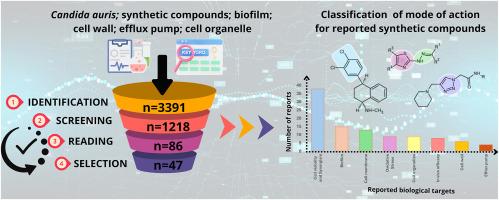Unveiling the mechanisms of synthetic compounds against Candida auris: An integrative review
Q2 Agricultural and Biological Sciences
Current Research in Pharmacology and Drug Discovery
Pub Date : 2025-01-01
DOI:10.1016/j.crphar.2025.100231
引用次数: 0
Abstract
The multidrug-resistant fungal species Candida auris has drawn attention from across the world due to its capacity to elude traditional therapies and flourish in medical environments. Its resilience, which includes biofilm development and efflux-mediated drug resistance, highlighted the need for novel antifungal approaches. Despite advancements in antifungal therapeutics, the rising prevalence of resistance and limited antifungal arsenal demand ongoing research into novel and more effective treatments. To tackle this rising issue, the available literature suggests several approaches. Among those, the use of synthetic compounds (SCs) appears as first-line option. However, to prove the efficacy of these SCs against C. auris a complete coverage is still elusive in a single study. Thus, in this integrative review, we aimed to summarize the anti-C. auris SCs that are reported in literature. About 47 articles were included in this review using predefined selection criteria. Data were extracted for detailed reviews from PubMed, Google scholar and Science direct. All the included studies tested antifungal activities of the SCs and evaluated their mode of actions. These data highlighted diverse modes of action such as perturbation of biofilm formation, disruption of cell wall and organelles, inhibition of efflux and generation of reactive oxygen species to name few. Taken together, SCs represent viable candidates for effective antifungal treatment. The information gathered in the present study emphasizes the need for further investigations, including preclinical studies and clinical trials, to evaluate the therapeutic potential of these agents against C. auris.

揭示合成化合物抗耳念珠菌的机制:综合综述
耐多药真菌品种耳念珠菌因其能够避开传统疗法并在医疗环境中蓬勃发展而引起了全世界的关注。它的弹性,包括生物膜的发育和外排介导的耐药性,强调了新的抗真菌方法的需要。尽管在抗真菌治疗方面取得了进展,但不断上升的耐药性和有限的抗真菌武器库需要持续研究新的和更有效的治疗方法。为了解决这个日益严重的问题,现有文献提出了几种方法。其中,使用合成化合物(SCs)似乎是一线选择。然而,为了证明这些SCs对金黄色葡萄球菌的疗效,在单一的研究中仍然难以完全覆盖。因此,在这篇综合综述中,我们旨在总结抗c。有文献报道的耳廓SCs。本综述采用预定的选择标准纳入了约47篇文章。数据从PubMed, b谷歌scholar和Science direct中提取以进行详细评论。所有纳入的研究都测试了SCs的抗真菌活性并评估了它们的作用模式。这些数据强调了不同的作用模式,如生物膜形成的扰动,细胞壁和细胞器的破坏,抑制外排和活性氧的产生等等。综上所述,SCs是有效抗真菌治疗的可行候选药物。本研究收集的信息强调需要进一步的研究,包括临床前研究和临床试验,以评估这些药物对金黄色葡萄球菌的治疗潜力。
本文章由计算机程序翻译,如有差异,请以英文原文为准。
求助全文
约1分钟内获得全文
求助全文
来源期刊

Current Research in Pharmacology and Drug Discovery
Agricultural and Biological Sciences-Animal Science and Zoology
CiteScore
6.40
自引率
0.00%
发文量
65
审稿时长
40 days
 求助内容:
求助内容: 应助结果提醒方式:
应助结果提醒方式:


